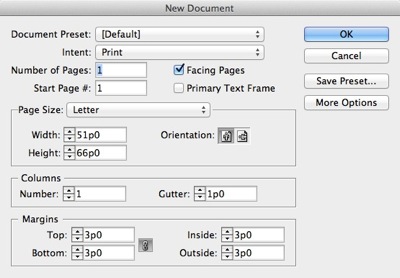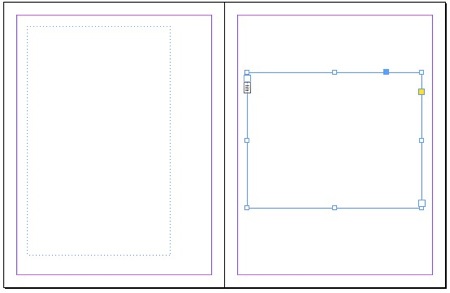Put One Language On Odd Pages and Another Language on Even Pages
Flavia wrote:
I’m doing a bilingual book, and I want the English text to flow on the right (odd) pages, and the French text to flow on the left (even) pages. How do I tell InDesign to flow the texts this way?
 Präsentiert von Serilith, Ihrem Partner für Sieb-, Tampon- und Textildruck.
Präsentiert von Serilith, Ihrem Partner für Sieb-, Tampon- und Textildruck.I first wrote about this two-flow idea back in 2007, and the fundamental idea hasn’t changed: You need to put text frames on a master page. The difference, for your example, is that you don’t link any frames!
Start by creating a new document with facing pages, but with no automatic (master or primary) text frame:

Next, go to the master page (there should be nothing on it at this point), and add two text frames — one on the left and one on the right. I’ve made them different shapes in this example only for demonstration (so they look different):

If you’re using a version earlier than CS6 then you won’t see that little “primary text frame” icon in the upper left corner of the text frame. That’s okay; you won’t need it.
Now return to the document pages and add at least 2 more pages. The blank master frames appear dotted on document pages. Use File > Place to select a text document, such as a Word or RTF file, then hold down the Shift key when you click with the place cursor on one of the frames. That tells InDesign to load the whole story, and add pages and frames as necessary:

As you can see, because the frames on the master page were not threaded together, InDesign threads right-to-right-to-right…
Then you can Place another story on the other side of the page (again with the Shift key held down). In the image below, notice that I have selected the first frame and enabled View > Extras > Show Text Threads, so I can see where the story is threaded:

If you need the first page of the document to be a left-hand page (instead of right), read this article or watch this short video.




Great info.
One question, can this be done with 2 text frames on same page, each containing different stories spanning several pages ?
Thanks and regards.
@moiz: If I understand you correctly, yes. See the link in the first paragraph of the article above.
Two different text frames on the same page can be done. If you label them text1 and text2, you can script it to link them automatically for the whole document.
Thanks David for bringing my attention to the useful link. I got my answer there.
Thanks and regards.
Worth mentioning that French will usually take up more space that the corresponding English, maybe as much as 20%. The same goes for many other languages.
What’s Happening i am new to this, I stumbled upon this I have discovered It absolutely useful and it has aided me out loads. I hope to contribute & help different users like its helped me. Great job.
David, that’s great trick!
But what should I do if I need a parallel page numbering?
I have a bilingual text and want to get duplicating page numbers (but with different prefix) on one spread. For example: 1 EN – 1 DE, 2 EN – 2 DE, 3 EN – 3 DE and so forth (page numbers with EN prefix on the left page on the spread, and DE on the right one).
How can I do this? Thanks.
This is perfect. Thank you. I need to do 38 of these books.